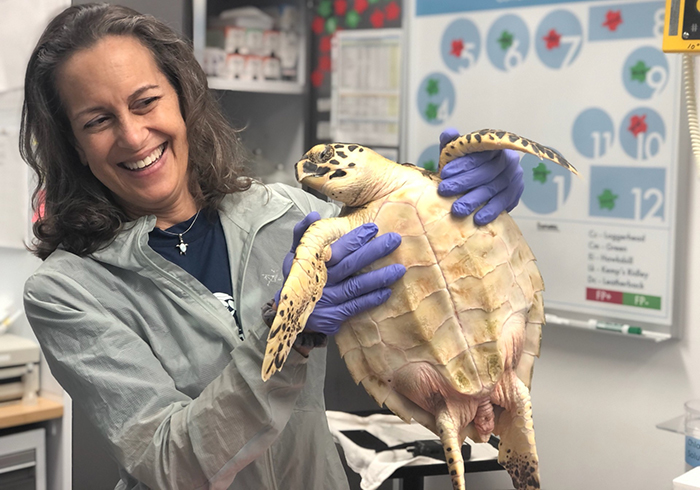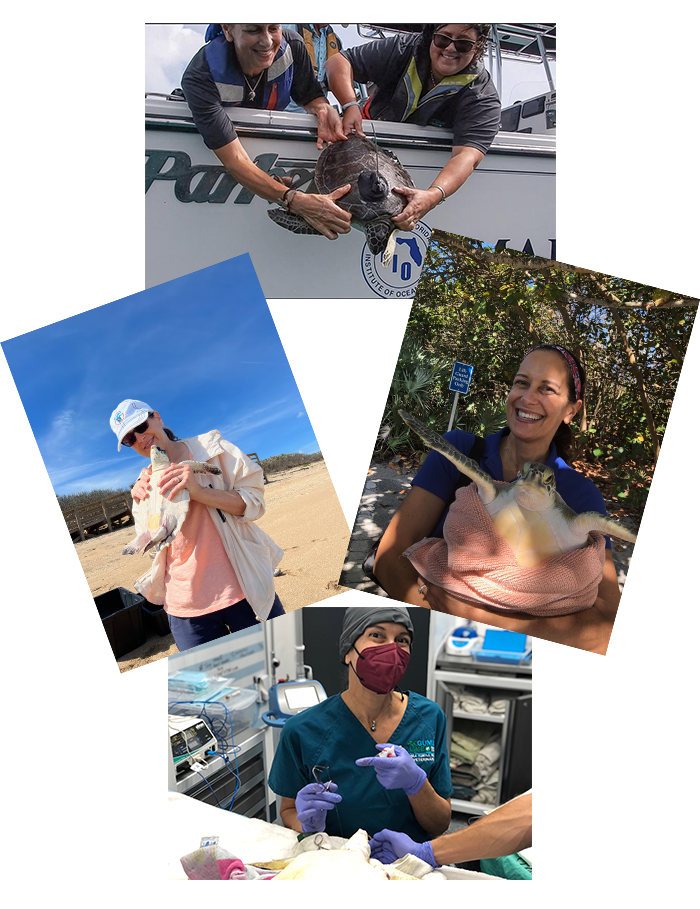
Maria Chadam, AB’88, releases a green sea turtle (Chelonia mydas) at Red Reef Park in Boca Raton, Florida: “We release the turtles as close to where they were stranded as possible.” (Photo courtesy Maria Chadam)
Veterinarian Maria Chadam, AB’88, is over pocket pets and into sea turtles.
Maria Chadam, AB’88, the primary veterinarian at Sea Turtle Care and Conservation Specialists in Delray Beach, Florida, has been working with sea turtles since 2009. Her interview has been adapted and condensed for space.—Isabella Romeu, Class of 2026.
I have always worked with dogs and cats and pocket pets—small rodents like hamsters, gerbils, and mice. You don’t get trained in sea turtle medicine in vet school.
I graduated from Cornell’s College of Veterinary Medicine in 1998 and moved to southern California. I started working in a vet clinic, and it clicked for me. It’s medicine. When I was in the College, I wanted to go to med school and go into pediatrics. This is similar to dealing with humans, just with a different type of child.
I moved to Florida in 2005 and have been here for almost 19 years now. I do house calls for cats and dogs, and I also do sea turtle rehabilitation. I did not work with sea turtles until 2009, when I started at Gumbo Limbo Nature Center, learning to do surgery.
Sea turtles are a very niche species for veterinarians. One of my first experiences was being trained to do eye surgery. It was intense but fun. I helped develop new techniques to take tumors off turtles’ eyes. I stayed with that nonprofit until a year ago February, so I was with them for around 13 years.

Now I am affiliated with a new non-profit, Sea Turtle Care and Conservation Specialists. I am their primary veterinarian and on the board. I’m helping the group to obtain a rehabilitation permit and a space for tanks in Palm Beach County. Right now we hold a stranding and release permit.
I have never been bitten myself, but I’ve seen other people get bitten. It depends on the species. For example, loggerhead turtles tend to be more friendly, especially if they’re being fed. If you have a tank with a window, for some reason, they like to go right up to the glass and look at small children.
Loggerheads get attacked by sharks, so they get a lot of flipper injuries. I enjoy doing wound management. Although loggerheads can be huge, you can drain the tank, go in there, and treat them without giving them a lot of sedatives. I find them relatively easy to work with and the medicine is satisfying.
Now hawksbills are feisty. They don’t usually interact; they’re solitary. Green sea turtles can go both ways. As a rule, the bigger and older the turtle is, the feistier and more aggressive they are, especially adult males.
The anatomy of sea turtles is really exciting. Their salt glands, which are behind the eyes and help regulate the sodium intake from the ocean water, produce a sticky substance that comes out of the eye like tears. They have magnetite crystals in their brains that help them use the earth’s magnetic field to navigate. We think this guides them back to their original beaches where they had hatched to lay their eggs as adults. This “magnetoreception” is also found in some bird species, bees, salmon, lobsters, dolphins, and rodents.

We try not to bond with turtles because we’re trying to teach the public not to anthropomorphize them. But we do name them. The names are usually based on a theme, but not always. In the past we’ve used scientific terminology and winter as themes. Right now we have Georgie, Captain, Freed, Veronica, and Millie. These are all educational turtles and are typically named by donors or school groups.
My most recent technician is in her second year of veterinary school at the University of Florida. I helped her get into veterinary school—it’s a complex and competitive niche to break into. I’m mentoring her to take over what I’m doing. She has been soaking up my general knowledge for about four years already. I love mentoring young women. I started to get into doing that in the past five years.
I was a biology major, and I had people deterring me from applying to medical school. They told me it was just so competitive. When I worked in research out of college, I was in an anesthesia lab, and the doctors were even more discouraging of me going to med school. I don’t want young women to have to go through that.
So many of my colleagues who have worked with dogs and cats all their lives have gotten bored. But it’s hard to be bored when you’re working with sea turtles.
I look at sea turtles as ambassadors of the ocean. They say a lot about the ocean’s health. If they’re thriving, the ocean’s thriving.
This story subsequently appeared in the Fall/24 print edition of the Core.
